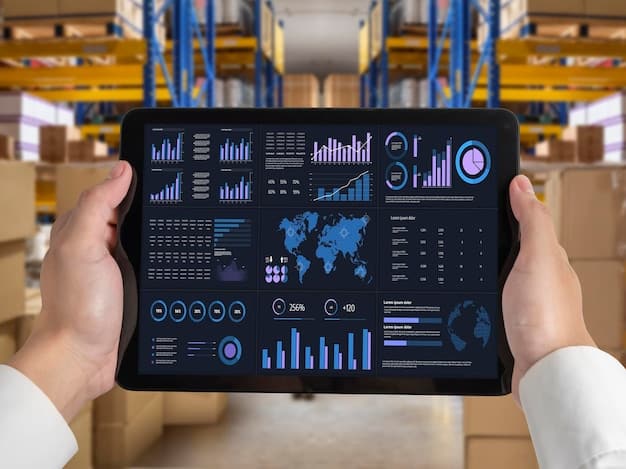Minimize Supply Chain Risk: 3 Strategies for Profitability

Supply chain disruptions can significantly impact profitability; however, by implementing risk mitigation strategies such as diversification, leveraging technology, and building resilient relationships, businesses can minimize these risks and maximize profitability.
Navigating the complexities of today’s global market requires acute awareness of potential disruptions to your supply chain. Implementing proactive measures is not just about survival; it’s about creating a competitive edge to bolster profitability. In this article, we’ll look into three key strategies to help you minimize risk and maximize profitability despite potential challenges in your supply chain.
Understanding Supply Chain Disruptions
Supply chain disruptions are events that interrupt the normal flow of goods and services, causing delays, shortages, and increased costs. Understanding what causes these disruptions, and their impact is crucial for businesses aiming to minimize their impact and maintain profitability.
Common Causes of Supply Chain Disruptions
Numerous factors can lead to supply chain disruptions. These can range from natural disasters to geopolitical events. Here are some main causes to consider:
- Natural Disasters: Hurricanes, earthquakes, floods, and other natural disasters can damage infrastructure, halt production, and disrupt transportation routes.
- Geopolitical Instability: Political conflicts, trade wars, and sanctions can create uncertainty and disrupt the flow of goods between countries.
- Economic Fluctuations: Changes in demand, inflation, and currency exchange rates can impact the cost and availability of materials and products.
- Technological Failures: Cyberattacks, system outages, and equipment malfunctions can disrupt communication, production, and distribution.
- Pandemics: Global health crises can lead to lockdowns, travel restrictions, and labor shortages, significantly impacting supply chains.
By identifying these common causes, businesses can better prepare for and mitigate potential disruptions.
The Impact of Disruptions on Profitability
Supply chain disruptions can have severe financial consequences for companies. Some consequences include:
- Increased Costs: Delays and shortages can lead to higher transportation costs, expedited shipping fees, and increased prices for raw materials.
- Lost Sales: Inability to fulfill customer orders can result in lost sales, decreased market share, and damage to brand reputation.
- Production Downtime: Disruptions can halt production, leading to idle labor, underutilized equipment, and missed production targets.
- Inventory Management Issues: Disruptions can result in excess inventory of some items and shortages of others, leading to increased holding costs and potential obsolescence.
Understanding these impacts helps businesses prioritize their risk management efforts. Recognizing these potential impacts is the first step in developing strategies to protect profits.
In conclusion, understanding the causes and impacts of supply chain disruptions is essential for developing effective risk mitigation strategies. By identifying potential vulnerabilities and taking proactive measures, businesses can safeguard their operations and maintain profitability even in the face of disruptions.
Strategy 1: Diversify Your Supply Base

Diversifying your supply base is a key strategy for minimizing risk and maximizing profitability in the face of disruptions. Relying on a single supplier can create significant vulnerabilities, while diversifying ensures alternative options are available when disruptions occur.
The Risks of Single Sourcing
Many companies that depend on a single source expose themselves to multiple risks. These risks can include:
- Dependence: Relying on a single supplier makes you entirely dependent on their capabilities and stability. If the supplier faces issues, your entire supply chain is at risk.
- Lack of Leverage: Without alternative options, it’s difficult to negotiate favorable terms, pricing, and delivery schedules. This can lead to higher costs and reduced profitability.
- Limited Innovation: Single sourcing can limit access to new ideas, technologies, and process improvements. Multiple suppliers can inspire healthy competition and drive innovation.
These are all important factors when deciding to diversify you supply base.
Benefits of Diversification
Diversifying your supply base offers multiple benefits. These can include:
- Reduced Risk: Spreading your sourcing across multiple suppliers reduces the impact of any single point of failure. If one supplier experiences disruptions, you have alternatives to fall back on.
- Increased Flexibility: Multiple suppliers provide greater flexibility to adjust orders, switch between products, and respond to changing market demands. This allows you to be more adaptable and resilient.
- Competitive Pricing: Diversification fosters competition among suppliers, leading to better pricing and terms. This improves profitability and lowers costs.
By diversifying your supply base these benefits can be achieved.
How to Diversify Effectively
Diversifying your supply base effectively requires careful planning and execution. Here are some key steps:
- Assess Current Suppliers: Evaluate your current suppliers based on their reliability, capacity, and risk factors. Use this assessment to identify vulnerabilities and prioritize diversification efforts.
- Identify Potential Alternatives: Research and identify potential alternative suppliers in different geographic regions and industries. Look for suppliers that offer similar products or services but have different risk profiles.
- Qualify New Suppliers: Conduct thorough due diligence on potential new suppliers. Evaluate their financial stability, production capabilities, quality control processes, and compliance with ethical standards.
- Develop Relationships: Build strong relationships with your new suppliers through regular communication, site visits, and collaborative projects. This ensures they are integrated into your supply chain and aligned with your goals.
Diversifying your supply base is a strategic investment that enhances resilience and profitability. By reducing dependence on single sources, you can navigate disruptions more effectively and maintain a competitive advantage.
In conclusion, the strategy of diversifying the supply base is all about reducing risk by not relying on a single supplier. Multiple suppliers allows the company to take advantage of innovation, flexibility, and leverage in price negotiation.
Strategy 2: Leverage Technology for Transparency

Leveraging technology for transparency is crucial for minimizing risk and maximizing profitability in today’s complex supply chains. Technology helps businesses gain real-time visibility into their operations, identify potential disruptions early, and make informed decisions.
The Importance of Real-Time Visibility
Real-time visibility is essential for effective supply chain management. Benefits of real-time visibility include:
- Early Disruption Detection: Real-time data allows you to identify potential disruptions, such as delays, shortages, or quality issues, as soon as they occur.
- Informed Decision-Making: Access to accurate and up-to-date information enables you to make informed decisions about inventory management, production scheduling, and logistics.
- Improved Coordination: Real-time visibility enhances coordination among suppliers, manufacturers, distributors, and customers, leading to smoother operations.
The utilization of real-time visibility can help businesses navigate the complicated supply chains with greater dexterity.
Technology Solutions for Supply Chain Transparency
Various technology solutions can enhance supply chain transparency. These can include:
- Supply Chain Management (SCM) Software: SCM software provides end-to-end visibility into your supply chain, from raw material procurement to final delivery. It includes features such as inventory management, order tracking, and supplier collaboration.
- Blockchain Technology: Blockchain provides a secure and transparent platform for tracking goods and information across the supply chain. It can improve traceability, reduce fraud, and enhance trust among participants.
- Internet of Things (IoT) Sensors: IoT sensors attached to goods, equipment, and vehicles can provide real-time data on location, temperature, humidity, and other conditions. This data can help you monitor product quality, prevent spoilage, and optimize transportation routes.
Having the utilization of these technology solutions companies can make positive changes to their own supply chains.
Implementing Technology for Transparency
Implementing technology for transparency requires careful planning and execution. Here are some essential steps:
- Assess Your Needs: Identify the specific areas of your supply chain where transparency is most critical. Determine what data you need to collect, analyze, and share with stakeholders.
- Choose the Right Solutions: Select technology solutions that align with your needs and budget. Look for solutions that are scalable, flexible, and easy to integrate with your existing systems.
- Train Your Employees: Provide thorough training to your employees on how to use the new technology solutions effectively. Ensure you understand how to use the data to make informed decisions.
- Monitor and Optimize: Continuously monitor the performance of your technology solutions and make adjustments as needed. Optimize your processes and workflows to maximize the benefits of increased transparency.
As a result of implementing these steps businesses can stay on top of their transparency needs.
In conclusion, leveraging technology for enhanced transparency is a strategic imperative for modern supply chains. By providing real-time visibility, enabling informed decision-making, and fostering collaboration among stakeholders, technology can help you minimize risk and maximize profitability.
Strategy 3: Build Resilient Supplier Relationships
Building resilient supplier relationships is essential for minimizing risk and maximizing profitability. Suppliers are integral to your supply chain, and strong, collaborative relationships can help you weather disruptions more effectively.
The Value of Strong Supplier Relationships
Strong relationships with your suppliers offers multiple benefits. These can include:
- Increased Trust: Trusted suppliers are more likely to go the extra mile to support you during a disruption. They may prioritize your orders, offer flexible terms, or provide access to alternative resources.
- Improved Communication: Open and transparent communication is essential for effective collaboration. Strong relationships enable you to share information, expectations, and concerns freely.
- Collaborative Problem-Solving: When disruptions occur, strong relationships facilitate collaborative problem-solving. You and your suppliers can work together to identify solutions, mitigate impacts, and restore operations quickly.
As a result of having these items a business can increase the success of its supplier relationships.
Strategies for Building Strong Relationships
Building strong supplier relationships is an ongoing process that requires commitment and effort. Here are some effective strategies:
Best Practices for Supplier Relationship Management
Supplier relationship management is all about managing the relationships that suppliers have with a business. Here are some ways to manage these relationships:
- Set Clear Expectations: Clearly communicate your expectations regarding quality, delivery, pricing, and ethical standards. Use contracts and service level agreements (SLAs) to formalize these expectations.
- Provide Regular Feedback: Provide regular feedback to your suppliers on their performance, both positive and negative. This helps them identify areas for improvement and ensures alignment with your goals.
- Offer Incentives: Offer incentives to your suppliers for meeting or exceeding your expectations. This can include bonuses, preferred status, or long-term contracts.
These are some important factors for management to keep in mind when looking at their various suppliers.
Ultimately, building robust supplier relationships is a strategic investment that enhances resilience and profitability. By fostering trust, improving communication, and promoting collaboration, you can create a supply chain that effectively handles disruptions.
In conclusion, the resilience of a supply chain is significantly bolstered by the strength of the relationships it maintains with its suppliers. These connections contribute to increased trust between both parties, improved communication to limit future problems, as well as collaborative problem-solving to create long term solutions.
| Key Point | Brief Description |
|---|---|
| 🤝 Diversify Supply Base | Reduce dependence on single suppliers for reduced risk. |
| ⚙️ Leverage Technology | Use SCM software and IoT for real-time visibility in the supply chain. |
| 🔗 Build Relationships | Foster trust and communication with suppliers for collaborative problem-solving. |
| 📈 Maximize Profitability | Implement all these strategies to protect and improve profitability during disruptions. |
Frequently Asked Questions
▼
Supply chain disruptions stem from different causes including natural disasters and geopolitical factors. Natural disasters like hurricanes, or geopolitical issues like conflicts, can disrupt manufacturing and transportation.
▼
Diversifying suppliers lessens reliance on any single source. It ensures there are alternative options if one supplier faces difficulties, maintaining stability. This helps businesses adapt quickly.
▼
Technology like SCM software and IoT sensors, allows for real-time visibility into supply chains. This enables quick identification of problems, informed decision-making, and smoother coordination.
▼
Strong relationships increase trust and communication with suppliers. In times of disruption, mutual trust ensures more flexible support and promotes collective troubleshooting to achieve more effective solutions.
▼
Businesses should monitor KPI, which include on-time delivery rates, supplier performance, inventory levels, cost savings, and risk factors. Regular review and response to change can improve strategy and lower potential business disruptions.
Conclusion
In conclusion, minimizing risk and maximizing profitability amidst supply chain disruptions requires diversification and leveraging technology. Building resilient supplier relationships is critical for protecting your supply chain. These strategies help create a robust and adaptable supply chain.


